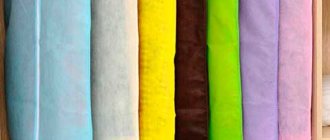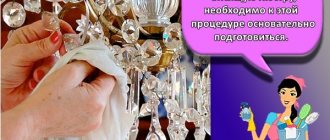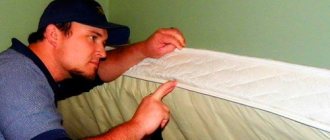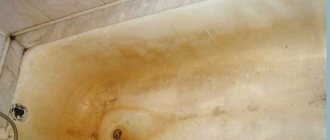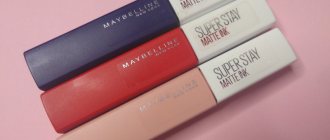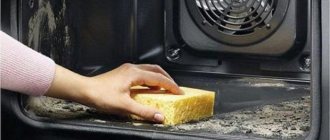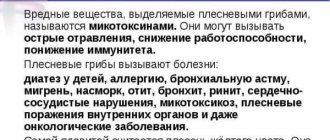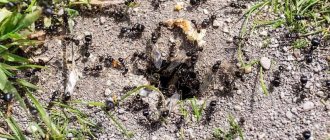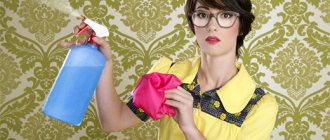Sooner or later, every technology lover has to deal with cleaning parts of various mechanisms from oils, dirt, soot, oxides, etc... Having sifted through a bunch of information in various sources, I will try to combine all the knowledge together to develop the most accessible, effective, safe and economically feasible methods cleaning. The results of the experiment will be supported by photo and video materials.
Minimum conditions: Bathroom, kitchen) Most craftsmen live in apartments without even a garage. And even then, the minimum garage suitable for anything other than storing a car and all sorts of rubbish, I think, is 5x4m.
I will not touch upon mechanical cleaning and abrasive blasting in this topic. There will be separate articles for them.
I decided to resort to searching for available methods of chemical cleaning after I submitted the aluminum parts to sandblasting. The advantages of sandblasting are its efficiency and versatility, and overall I was pleased with the result. But there are also disadvantages that I personally encountered: 1. Inaccessibility in many localities. 2. Price. 3. Using mainly only sand, and as a result, it strongly mattes and eats soft metals and alloys, threads, polished surfaces, etc... 4. Cleans only surfaces in direct view of the abrasive flow, and does not clean hidden channels and tubes, etc...
I also tried various chemical cleaners in cans from auto chemical stores. In general they work, but the consumption and price are ruinous.
And now to the point :) Reagents: 1. Any gasoline (A92-98). 2. Solvent (646,647 and similar). 3. Washing powder/liquid soap/dishwashing detergent. In general, any source of surfactants. 4. Sodium carbonate (Soda ash, washing soda). 5. Sodium hydroxide (Caustic soda, Caustic soda, Mole pipe cleaner). 6. Sodium silicate (Liquid glass, silicate glue).
We clean the part with a soft spatula from a thick layer of dirt and oil (Without scratching, there is no need to scratch with a screwdriver.) Wooden sticks are suitable for stirring sugar. We take a plastic bucket according to the size of the part. Mix a little detergent in 50 grams of gasoline. Using various soft brushes, we clean the part in the bucket with the prepared mixture. This slurry dissolves thick layers of dirt and flows into a bucket. And so on repeatedly, with the same liquid, until the main dirt is washed off. You can wash several parts in the same portion of such a gasoline solution. When there is a lot of dirt in the mixture, flush the waste down the toilet. You cannot take a lot of gasoline because the vapors are explosive. Yes, even a small amount is enough. We rinse the parts with warm running water to remove the bulk of the remaining dirt, while the water flows into a bucket. The waste is poured into the toilet, I don’t recommend it into the bathroom))) It turns out quite neatly, so you won’t be kicked out of the house))) We repeat the same procedure using a pure solvent without detergent. What gasoline did not remove, solvent will remove. This is especially true for soot and soot. Carry out work with the hood on! And even better with the necessary protective equipment: gloves, carbon respirator, goggles or mask.
Solution for cleaning aluminum and its alloys (In principle, it is universal and the most gentle for all metals and alloys): For 1 liter of water: Sodium carbonate - 20 g. (Soda ash, washing soda. Corrodes dirt. Weak alkali). Detergent - 10g. (Powder, soap, etc.). Sodium silicate - 10g. (Liquid glass. Acts as a coagulant. Does not allow dirt to settle again on the part. Binds dirt). Dissolve all this in hot/warm water in the described proportions.
Boiling bath: Take an enamel bucket/basin. Galvanized and, in extreme cases, plastic for hot water are also suitable. Pour in the hot solution so that it covers the submerged parts. We place an enameled or galvanized bucket on a gas stove and slowly boil it, checking the condition of the parts. All dirt should fall behind and float on top. If necessary, change the solution and repeat. Soda ash does not eat or blacken aluminum and its alloys. The parts should turn white and “rumble”) Instead of a gas stove, you can use a boiler. By the way, for a plastic container this is the only acceptable way to boil the solution. A steel bridge is placed over the plastic bucket; a skewer will do. The boiler is hung on it so that it does not touch the walls and bottom of the plastic bucket. You need to be careful not to move and melt the bucket. I’ll send you videos and photos...
Aluminum is a fairly light and durable metal, and therefore is often used in the kitchen as the main material from which cookware is made. When plaque appears, it becomes unpleasant to cook in it, and it is impossible for safety reasons, and therefore the question arises of how to clean aluminum until it shines.
Cleaning features, general recommendations
Heating of aluminum cookware occurs evenly and does not require much time. After some time, carbon deposits begin to appear on aluminum cookware and traces of oxide become noticeable. Most often, they try to clean aluminum using dishwashing detergent, but it can only remove external dirt and grease.
Dishes made from this material should only be washed cold, since they can easily be damaged when hot. If a hot metal is immersed in cold water, it will become deformed, and therefore you should try to avoid such a failure.
You should not try to clean burnt food immediately using iron sponges and other objects. To make the task easier, you just need to pour warm water and wait about half an hour. During this time, the food will get wet and can be removed using a regular dishwashing sponge.
It is not recommended to wash aluminum cookware in the dishwasher, since the dishwasher uses hot water during the washing process, which can damage the material. To avoid deformation, it is recommended to wash aluminum cookware by hand with warm water.
You should not use strong acids in the process, as they will not be able to restore the shine of the dishes, and may harm them. It is also not recommended to clean it with metal sponges, which leave scratches on the dishes.
Video
To understand the nuances of cleaning aluminum, watch the following videos:
Young mother, wife and part-time freelancer. Being a lawyer by training, I am accustomed to collecting and providing the most complete and reliable information. Constantly improves in the professional field and strives for personal growth and development.
Found a mistake? Select the text with the mouse and click:
There are special traps to combat moths. The sticky layer with which they are covered contains female pheromones that attract males. By sticking to the trap, they are eliminated from the reproduction process, which leads to a decrease in the moth population.
The habit of using an automatic washing machine “sparingly” can lead to the appearance of an unpleasant odor in it. Washing at temperatures below 60℃ and short rinses allow fungi and bacteria from dirty clothes to remain on internal surfaces and actively multiply.
Fresh lemon is not only suitable for tea: clean dirt from the surface of an acrylic bath by rubbing with half a cut citrus, or quickly wash the microwave by placing a container of water and lemon slices in it for 8-10 minutes at maximum power. The softened dirt can simply be wiped off with a sponge.
If your favorite things show the first signs of gestation in the form of untidy pellets, you can get rid of them using a special machine - a shaver. It quickly and effectively shaves off clumps of fabric fibers and returns things to their proper appearance.
Threads made of gold and silver, which were used to embroider clothes in the old days, are called gimp. To obtain them, the metal wire was pulled for a long time with pliers to the required fineness. This is where the expression “to drag out the rigmarole” came from - “to do long, monotonous work” or “to delay the completion of a task.”
Stretch ceilings made of PVC film can withstand from 70 to 120 liters of water per 1 m2 of their area (depending on the size of the ceiling, the degree of its tension and the quality of the film). So you don’t have to worry about leaks from neighbors above.
The dishwasher cleans more than just plates and cups. You can load it with plastic toys, glass lamp shades and even dirty vegetables, such as potatoes, but only without using detergents.
The easiest way to remove scale and carbon deposits from the soleplate of the iron is with table salt. Pour a thick layer of salt onto the paper, heat the iron to maximum and run the iron over the salt bed several times, applying light pressure.
Before removing various stains from clothing, you need to find out how safe the selected solvent is for the fabric itself. It is applied in a small amount to an inconspicuous area of the item from the inside out for 5-10 minutes. If the material retains its structure and color, you can move on to stains.
Cleaning aluminum cookware
The main disadvantage of aluminum is its softness. It is very easy to damage and also leave scratches on it. Even with frequent washing with a melamine sponge, the surface will soon begin to become matte, as a large number of micro-scratches will remain on it.
- To restore shine, you need to use borax, ammonia and GOI paste. The latter needs to thoroughly rub the aluminum, and then, using a rag soaked in solvent, thoroughly rub the cutlery.
- Aluminum cookware can be cleaned with such products as soap, ammonia, table vinegar and table salt.
- Soot, oxide and other contaminants that accumulate on aluminum cookware can be easily removed using soft foam sponges or polymer bristles, microfiber or cotton cloths, and rags. It is necessary to ensure that they do not contain rougher and harder materials that can leave scratches.
- A good aluminum cleaner is a special product designed for cleaning glass or porcelain. They do an excellent job, gently removing dirt and adding shine to the dishes.
The main reasons for the accelerated oxidation of contacts in a car
Oxidation of contacts occurs in all electrical and electronic devices, including household and industrial appliances and electrical wiring. However, in a car the oxidation process occurs with greater intensity. The main reasons for accelerated oxidation of contacts in a car are as follows:
- increased humidity in vehicle systems;
- increased temperature in the engine compartment, accelerating the process of interaction with oxygen;
- presence of foreign ingredients (antifreeze, oil, mold, mildew);
- the flow of large currents leading to sparking and burning of contacts;
- interaction with the salt composition of road treatment.
The destruction of contacts is not always associated with the process of interaction with oxygen. For example, the destruction of battery terminal contacts is often explained by oxidation, although they are destroyed by acidic fumes. The destruction of a conductor by fungus and mold is closer to organic processes than traditional oxidation.
Remove carbon deposits
Cleaning oxides and carbon deposits is also quite simple. This will require funds and products that many people have in their homes. Moreover, such cleaning does not take much time and does not require serious effort.
- Aluminum is clarified using brine from cucumbers, fermented milk products such as milk and kefir. It is necessary to pour the available product into the dishes that need to be cleaned for half a day. Most often they leave it overnight so that you can simply wash the dishes in the morning. If you need to clean some objects from carbon deposits, they can be placed at the bottom of the container that was filled. Cleansing occurs thanks to the acids found in these products.
- A sour apple will help clear carbon deposits and remove oxidation. The fruit needs to be cut in half and rubbed onto the desired surface until shiny. The acid will corrode all dirt, and therefore, after rinsing with water, the item will shine.
- Contaminants can be removed using a saline solution. You need to take salt and water in equal proportions, and the first ingredient should be completely dissolved. Using a sponge, you need to apply the solution to the item that requires cleaning, leave it in this state for a while, and then rinse thoroughly with water.
Prevention measures
In order not to think about how to boil a pan and get rid of contaminants, you should study preventive measures to reduce the likelihood of such a problem occurring. The most effective method of prevention is to soften the water. It is the hard liquid that worsens the condition of the utensils. Special filters will help with this. It is recommended to wash dishes thoroughly and frequently. This will allow you to remove the top layer of plaque and prevent it from becoming neglected.
It is recommended to wash dishes thoroughly and frequently.
Plaque affects the appearance of the dishes, its functions and the health of family members. At the first signs of contamination, they should be removed immediately. In the initial stages, this will be faster and easier to do. To do this, it is worth using available means that are effective.
Remove corrosion and oxide
Cleaning aluminum objects - a flask, dishes, coins - is quite simple if you know the easiest methods to do it. It is recommended to use traditional methods rather than standard dishwashing detergents, which will not cope with heavy stains.
Cream of tartar
You can remove blackness from aluminum using cream of tartar. Cleaning aluminum from oxide and corrosion with this product is quite simple: you just need to pour hot water into a bowl, dissolve the stone in it and add a small amount of citric acid. You need to bring the resulting solution to a boil, let it cool and wipe all the walls with a soft cloth.
Cream of tartar can be diluted with water to form a paste that can be rubbed onto dishes like a cleaning powder. This will help restore the shine to the material.
Table vinegar
Using 9% table vinegar, aluminum can be easily cleaned. This method is usually used for coins, but will actually clean more than just coins. If we are talking about dishes, then you just need to pour the solution into it and bring to a boil. Then let it cool and wash the item. If you need to clean other things, they should be boiled in this solution and then washed.
How to clean a surface using traditional methods?
The appearance of lime deposits is a natural process. A light coating on the inside of pots and kettles is associated with the accumulation of sediment, which is formed as a result of heating hard water containing a large number of various impurities.
The trace elements that make up the liquid (potassium, magnesium, etc.) form the basis of such difficult-to-remove accumulation. In the process of heating water, chemical reactions begin to occur, producing carbon dioxide and solid sediment.
Lemon acid
Citric acid is a widely used descaling agent for dishes. If there is not too much sediment on the surface, then local treatment can be carried out.
To do this, you can simply apply acid granules to a damp sponge and rub the desired areas, then wash the pan in water. This method does not always give good results.
If the result is unsatisfactory, then you can use another technique:
- Fill the pan with water so that all areas with scale are covered with it.
- Add a packet of citric acid.
- Bring the solution to a boil.
- Boil for another quarter of an hour.
- Turn off the stove.
- After the water has cooled, wash the pan.
Vinegar
Table vinegar is a worthy alternative to special descalers. The effect of such cleaning is associated with a chemical reaction in which acetic acid reacts with precipitated calcium and magnesium salts.
Directions for use (based on a container volume of 3-5 liters):
- pour 1 cup of vinegar into an empty pan;
- add water;
- boil;
- leave to simmer for 5 minutes;
- switch off;
- set the pan aside until it cools completely;
- drain the solution;
- rinse the container.
The downside of this method of descaling is the pungent, specific smell of vinegar, which only intensifies when heated. The resulting steam can be dangerous, so it is best to carry out all work with good ventilation.
Another vinegar-based method:
- Moisten the inside of the pan generously with undiluted vinegar using a napkin.
- Leave the container to stand for 2 hours.
- Rinse with a sponge.
This method may be ineffective with a thick layer of scale.
Soda
Baking soda creates an alkaline environment that effectively attacks scale deposits.
The abrasive effect of such cleaning is small, so the method of removing deposits is well suited for almost all types of surfaces.
Cleaning steps based on a 5 liter vessel:
- pour water into the container;
- add ½ standard pack of soda;
- bring to a boil;
- leave to boil for at least 2 hours;
- remove from heat;
- cool to room temperature;
- rinse thoroughly.
Prolonged boiling will cause the water to begin to evaporate, so it will need to be added during the process.
Cucumber pickle
The acid contained in cucumber pickle can be used as an effective descaling agent.
The cleaning process is very simple:
- Pour in brine until all areas of scale are covered.
- Leave the pan standing like this for about a day.
- Drain.
- Clean the inside using the hard side of a sponge and dish detergent.
- Rinse.
Whey can also be used in a similar way.
Ascorbic acid
For use as a descaling agent, ascorbic acid is ground into powder. Depending on the volume of the pan, prepare a solution based on the proportion: 1 tablespoon of powder for every liter of water.
The resulting solution is poured into a container and brought to a boil. After the pan has cooled, the contents are drained and the pan itself is washed.
Potato (apple) peels
Apple or potato peels can also help remove scale and add shine to the surface. The effect is explained by a combination of high heating temperature and substances present in potatoes and apples.
Procedure:
- the peel is placed in a container and filled with water;
- bring to a boil;
- boil for half an hour;
- Rinse the inside of the pan in running water.
The more cleanings used, the better the result.
Sparkling water (Sprite, Coca-Cola, etc.)
Carbonated drinks will also help in removing limescale from the surface of pans. It is removed by exposing the sediment to carbon dioxide and citric acid present in the drinks.
Procedure for descaling:
- Pour sparkling water into the pan so that all lime deposits are covered with liquid.
- Boil.
- Set aside for 8-10 hours.
- Drain.
- Rinse the dishes.
Recommendations and care tips
Before using aluminum cookware for the first time, it is recommended to calcine it thoroughly. To do this, it is recommended to pour a small amount of sunflower oil and a tablespoon of salt into the bottom of the pan, and then keep it on the fire for a while, stirring the salt. After completing the procedure, it is recommended to wait for the dishes to cool, after which they should be washed thoroughly.
It is not recommended to use abrasive products when washing, as they can remove the protective layer, which will subsequently cause the dishes to darken. If the dishes previously contained dairy products, eggs or dough, then you must first wash the dishes with cold water, and only then use hot water.
If you boil clean water or potato broth in an aluminum container, it may darken. In order for the dishes to acquire shine, you need to add a small amount of ammonia to it each time you rinse. It is also not recommended to store such types of products as pickles and mushrooms in dishes made of this material. And you can’t ferment cabbage in it either.
It is necessary to protect dishes made from this material from mechanical damage, since aluminum bends and breaks easily. This point especially applies to lids. If you follow these few care rules, products made from this material will delight you with cleanliness and shine for a long time.
Aluminum is a lightweight, durable metal that heats up quickly and evenly. These qualities make it suitable for the manufacture of kitchen utensils, primarily pots and pans, and colanders.
However, initially shiny or evenly matte aluminum household items lose their attractive appearance, becoming covered with oxide, stains, a hard-to-remove coating, or burning to blackness.
It is unpleasant and even dangerous to use such utensils for cooking. Therefore, it is recommended to figure out how to clean aluminum utensils and rid them of carbon deposits and oxides.
Special attention to copper coins
Copper coins have long gone out of use. However, many of us have them, and the oldest of the copper coins are antiques. Of course, both numismatists and ordinary owners of antiques care about the appearance of their “well-being.”
There are several methods for reviving old copper coins. The appearance of the surface of the money will tell you which way to act.
Fragments of green dirt are removed with 10% citric acid. The reddish tint is eliminated with a 5 percent ammonia solution or with ammonium carbonate. Yellow plaque is removed with a 10% vinegar solution.
There are also technologies that can be used to age coins. A noble layer of patina can be created using the following solution:
The composition is gradually heated, without bringing to a boil. Next, coins are placed in it, which are turned over to assess their condition. As the appearance of the money reaches the desired level, it is removed from the solution. The coins are dried and, if desired, to consolidate the effect, they are wiped with a mixture of ethyl alcohol and benzene in equal quantities.
Choice of product
The disadvantages of aluminum include the softness of the metal and its instability to abrasive influences. If you plan to keep your pans shiny for longer, avoid using wire wool, brushes, abrasive sponges, or sandpaper.
Even the use of a melamine sponge, which can rid the metal of the oxidation film, will affect the appearance of the utensils - the shiny surface will become dull due to numerous micro-scratches.
Polishing with GOI paste will help return it to ideal condition - rub a rag soaked in a solvent with a piece of hard paste, and then polish the metal surface to a mirror shine.
When choosing how to clean aluminum, you should pay attention to substances that are almost always at hand for any housewife. These include:
- laundry soap;
- baking soda;
- salt;
- table vinegar;
- lemon juice or citric acid;
- dairy products;
- cream of tartar;
- office glue;
- oxalic acid, etc.
When cleaning aluminum utensils from blackness, stains and carbon film, use brushes with semi-rigid polymer bristles, foam sponges, cotton or microfiber napkins, and rags.
If advice on how to clean a burnt pot or frying pan at home does not help you cope with the task, you can try using special products for cleaning porcelain and glass. Or resort to such means as “Chister”, “Bagi Shumanit”, “Oven Cleaner”, etc. Use special equipment according to the manufacturer's instructions.
New aluminum utensils shine attractively, but after some time of regular use they become dull and become covered with unsightly stains. Usually, housewives use the same usual composition for washing aluminum dishes as for pots and pans made of other materials, primarily stainless steel.
But this is the wrong approach. Conventional dishwashing detergents can clean the aluminum surface of ordinary contaminants, but they will not save you from oxidation and will not be able to completely protect you from the gradual formation of plaque, which, under regular exposure to high temperatures, turns into carbon deposits over time.
How to clean at home
There are several effective means that will help you clean the aluminum surface from the formed oxide at home.
To eliminate oxidation that has appeared on the aluminum surface, you can use baking soda. The main advantage of this product is its accessibility, since soda powder is available in almost every home.
Before you begin removing oxides, you need to prepare a solution. To do this, add 150 grams of soda to 300-400 milliliters of water. The mixture is stirred until a thick paste forms. Treat the damaged surface with the prepared mixture and wash it off with water.
Coca Cola
Many people believe that carbonated drinks can only be used as a drink, but this is not true. Housewives use them to remove rust and oxidation from metal surfaces. Among the most effective drinks is Coca-Cola, which will help restore an aluminum product. To remove oxides, the damaged coating is placed in a container with effervescent liquid and left for 40-60 minutes. If there is a lot of oxidation, the procedure is extended to 2-3 hours.
Sorrel
Some people use only oxalic acid, but even fresh sorrel leaves will help remove oxides. First, you need to place a bunch of sorrel leaves in a small saucepan and fill them with cold water. Then the container is placed on a gas stove and boiled for half an hour. When the liquid boils, the aluminum product is soaked in it.
The procedure lasts an hour and a half, after which the soaked surface is rinsed and wiped dry.
Lemon acid
Effective agents that help quickly eliminate oxidation include citric acid. It is added in the amount of two tablespoons to a liter container filled with cold water. Then the solution is brought to a boil, boiled for half an hour and removed from the gas stove. To remove newly appeared traces of oxides, wipe the surface with a sponge soaked in a solution of citric acid. To remove old oxidation, the product will have to be soaked in liquid.
Apple
Fresh apples contain trace elements that help remove oxidized stains from any metal surface. Using this method is very simple. It is enough to cut one apple into two equal parts, and then rub it on the oxidized mark. After 40-50 minutes, the treated coating is washed with soapy water and dried. If the stains remain, the procedure is carried out again.
Mustard powder, vinegar and salt
Sometimes, to eliminate blackening on the surface of aluminum products, products prepared from several components at once are used. A solution made from mustard powder, vinegar and salt is considered effective. The components are mixed to obtain a homogeneous mixture, after which a sponge is soaked in it and the oxidation is wiped off. 20 minutes after application, everything is washed off with warm water.
Salt
Aluminum cookware can be cleaned using table salt. To do this, add 85 grams of salt to a liter of heated water. The components are mixed until the salt particles are completely dissolved in the water. Then soak a cloth in the liquid and wipe the contaminated area. Before using the product, rinse it thoroughly to remove any remaining salt.
Acids
Effective anti-oxidation agents include products that contain natural acids. Most often, people use cucumber pickle, yogurt or regular kefir. Fill the container with any of the listed products, after which the aluminum part is soaked in it. After 10-15 hours, it is removed, rinsed and wiped off from remaining oxidized contaminants.
Cream of tartar
When removing dark spots on an aluminum surface, cream of tartar is often used. To do this, dissolve 100 grams of the product in five liters of heated water. Place the product in a container filled with liquid and soak it for at least two and a half hours. Then it is taken out and wiped with a dry sponge to get rid of any remaining traces of dirt. The procedure is carried out regularly, after the first dark spots appear.
Methods for cleaning aluminum from stains and oxides
Option 1. Acidic liquid. Plaque and dark spots can be removed by pouring kefir or sour milk, cucumber pickle, Coca-Cola onto the bottom of the dish and leaving it for 10-12 hours.
The sides of the pan can be wrapped in rags soaked in the appropriate composition and moistened with it several times, preventing it from drying out. After soaking, wash the utensils under running cool water and wipe off dirt with a soft cloth.
Option 2. Sour apples. Wipe the surface of aluminum cookware with sliced apples if they have darkened over time. After waiting about an hour, you can repeat the procedure. Then the dishes are washed and wiped with a rag or soft sponge.
Option 3. How to clean aluminum until it shines using table salt. If the pan turns black, place it in a solution of table salt at room temperature for half an hour or an hour.
To prepare the solution, use warm water and salt in a 1:1 ratio; it is important to wait until it is completely dissolved. After soaking with a sponge, clean the surface until shiny, then rinse with cool water.
Option 4. Cream of tartar. This is a classic method that has been used since the times when aluminum cookware just began to come into everyday use. Tartar forms at the bottom of containers in which wine is stored for a long time.
This precipitate is collected and dissolved in hot water. After the solution has cooled, a soft rag or napkin is well moistened in it, after which an aluminum object with traces of darkening and oxide is treated.
To polish the dishes to a mirror shine, prepare a thick paste from cream of tartar and water. Polishing will take a lot of time and require some effort.
Then the utensils are washed in cool water and wiped dry with a soft cloth. Cleaning with cream of tartar is considered more gentle compared to using citric acid or vinegar or exposure to high temperatures during boiling.
Option 5. Soda. Sodium bicarbonate is poured into a small bowl or other suitable container, a little water is added until a slurry forms. The resulting composition is applied to the darkened surface of the pan and rubbed with a soft cloth. After polishing, rinse the dishes thoroughly.
Option 6. Soap solution + polishing. Laundry soap shavings are dissolved in hot water, and utensils are soaked in it. Then they are washed and treated until shiny with a sponge using a mixture of ammonia (5 grams) and borax (15 grams).
How to remove rust from metal - description, photo
Metal is a material that has useful mechanical properties. But, nevertheless, over time it acquires an undesirable coating. And then the question of how to remove rust from metal becomes relevant. The article will list several accessible and effective ways to combat this problem on the following types of material:
- ferrous metals, steels and alloys;
- non-ferrous metal;
- fabrics.
Detailed recommendations are provided on how to properly clean surfaces. Brief tips are also given on how to protect the product from rust.
After a long winter, summer residents and rural residents begin painting metal fences, benches, and tables on their property. But before they begin the actual painting work, they remove old paint and rust using a very stiff wire brush. It is this that makes it possible to remove unwanted deposits from the surface of the metal, and also prevents further penetration and destruction.
Removing rust with a wire brush
This technique is good only and only if you plan to treat the metal surface with paint or anti-corrosion liquid/enamel. This method is also effective if the rust is only on the surface. But what should you do if you need to get rid of it not a fence made of iron rods, but, for example, a tank or even a washbasin? First, let's list how to tidy up ferrous metal products. And then we will briefly discuss how non-ferrous metals are processed.
Do not laugh! True, some food products can fight corrosion. Now you will find out exactly what methods exist to remove rust from a kitchen sink.
Lemon juice and vinegar
Take regular lemon and apple cider vinegar. First, assess the scale of the work. If you just need to clean the bottom of the sink, squeeze half a lemon into a glass or bowl. Perhaps you will get one spoon (tablespoon). Pour the same amount of vinegar. That is, you make vinegar and lemon in equal proportions. Stir.
Removing rust with food products
To avoid accidentally pouring all the liquid into the drain hole, it is advisable to plug it with a stopper or at least a bag. Spread lemon juice and vinegar over the dirty surface. Warn your household so that no one uses the washbasin for two hours. After the specified time, take a clean rag and wash the bottom and walls. The rust should come off easily.
Baking soda and water
This method is only good if the rust has not penetrated deep into the surface. If this condition is met, you can proceed.
Removing rust with soda
As a rule, it is advisable to wash metal dishes and the same washbasin with soda and water. What should be done? Take, for example, a tablespoon of soda and pour it into a cup. Next, pour in just a little warm (never hot) water and stir. You should get a thick paste. This paste should be used to lubricate the rust. After half an hour, scrub the surface with a steel wool.
Coca-Cola and other carbonated drinks
The world-famous Coca-Cola and Pepsi are unsafe drinks for the human body. We can talk about the harm for hours. But people buy them to...remove rust from metal! Now can you imagine what a terrible thing this is for your stomach?!
Removing rust with carbonated drinks
So, how to remove rust from metal using soda? Many motorists use this method to process small parts and large elements of their car. Often an old car requires serious repairs, and many nuts and bolts are “overgrown” with rust. In this case, you can buy one can of Coca-Cola, cut out the top and throw small parts into it.
Remove rust with Coca-Cola
The more rust, the longer you need to keep them in the jar (about 4-5 days). If the metal is damaged shallowly, it is enough to pour liquid onto the surface and rub with the hard side of the sponge until the plaque disappears.
Non-ferrous metals, like ferrous metal, can also acquire rust over time. But the ways of fighting are still different. You can use the same food products. For example, rust can be removed from brass products using:
- flour,
- salt (1 teaspoon),
- white vinegar (120 grams).
Salt and white vinegar are mixed in a container. You need to add enough flour to make a paste. This mixture is applied to the surface for half an hour and then washed off.
Removing rust from aluminum
But Alka-Seltzer tablets, which are sold in pharmacies and are intended to treat the liver, perfectly remove rust from aluminum objects. If the products are small and the coating is superficial, then fill the glass halfway with water and throw in one or two Alka-Seltzer tablets. Wait 5-10 minutes. Then rinse thoroughly.
Store-bought ketchup is suitable for fighting rust. Apply as usual to the metal surface, then rinse.
If there is rust on the fabric
It happens that the fabric has been located for a long time where rusty water flows, or it has been lying on a metal product all winter. What to do in this case? Lemon will come to the rescue again, or rather the juice of this healthy fruit. Next you will need an iron. Turn it on to warm up while you treat the stain on the fabric with lemon juice. Then you need to iron the stain with a hot iron. It may not disappear the first time. Therefore, you will need to repeat the procedure: pour lemon juice onto the stain again and iron it.
Professional cleaning methods
In addition to food products, you can also use special products if finances allow and if you do not have respiratory diseases/allergic reactions.
Prevention comes first
You can fight rust using any available means or buy the liquid at a hardware/automotive store.
Removing rust with special means
However, it is easier to prevent rust than to fight it. To do this, be sure to treat the metal with special anti-corrosion agents. Paint where appropriate. If possible, store metal parts and objects in dry places, wrapped in plastic or paper.
Source: https://stroymasterok.com/raznoe/kak-ubrat-rzhavchinu-s-metalla/
Methods for removing carbon deposits
Layered carbon deposits on the outside of the frying pan or food residues on the bottom that have burned and firmly stuck to the metal surface cannot be removed using the methods described above. Let's look at powerful cleaning methods.
Option 1. Soda + glue. Pots or pans made of aluminum, on the walls of which carbon deposits have formed, are soaked for 3-4 hours in a solution made from baking soda, office glue and water.
Ten liters of hot water are poured into a container of suitable size, then one hundred grams of soda and silicate glue are dissolved in it. Utensils soaked in a cooled solution are cleaned with a sponge until shiny and thoroughly rinsed in clean water.
Option 2. Table vinegar. If you do not have special tools at your disposal that can effectively clean a burnt aluminum pan, use regular table or apple cider vinegar (6 or 9%), you can also dilute the essence in a ratio of 1 part to 10 parts water.
Vinegar should be poured into a frying pan or pan with burnt food at the bottom. Place the dishes on the stove and turn on high heat. Bring the liquid to a boil, remove the frying pan or saucepan from the heat and let it cool completely.
When the temperature of the liquid reaches room temperature, use a sponge to wash off the remains of burnt food. Then the dishes are washed well under running water.
Vinegar can also be used to clean aluminum utensils from dark stains and oxide. It is enough to moisten a rag with the composition and carefully treat the aluminum surfaces.
When using vinegar, be sure to protect your hands with rubber gloves. If you choose the boiling option, open the window for ventilation and turn on the hood to prevent the pungent odor from spreading throughout the apartment.
Garage Recipes
There are several garage recipes that will help you make anti-oxidation products.
Boiling soda
Ordinary boiled water will help remove new traces of oxide. The liquid must be boiled in a small saucepan in advance. Then the boiling water is poured into a basin in which all parts that need cleaning will be soaked. The soaking time lasts about 3-4 hours. Then all products are washed and wiped from any remaining water. If the oxides have not disappeared, you will have to use other, more effective means.
A dense oxidized film can be removed using a special pharmaceutical borax. To restore an aluminum product, perform the following steps:
- add 10-15 grams of borax to a glass of water;
- stir 3-4 drops of ammonia into the mixture;
- treat the metal coating with the prepared liquid;
- after forty minutes, the remaining composition is washed off from the surface.
Sodium hydroxide
You can remove a layer of stubborn dirt with caustic soda. The advantages of this procedure include the fact that it is easy to carry out at home. The product in an amount of 150-200 grams is added to 7-8 liters of water and mixed thoroughly. It is necessary to use heated water, the temperature of which is 60-80 degrees. The part should be washed with the prepared sodium solution.
Coca Cola
This carbonated drink has excellent cleaning properties that help restore contaminated aluminum coatings. Several liters of Cola are poured into a saucepan. Then the product is placed in it and soaked for about an hour. During this time, the darkening should completely disappear.
If Cola did not help cope with the oxide, then you will have to use a more effective remedy.
To come in
Already registered? Sign in here.
There are currently 0 users on the page
There are no users viewing this page.
This article was produced by our experienced team of editors and researchers, who reviewed it for accuracy and comprehensiveness.
Number of sources used in this article: 10. You will find a list of them at the bottom of the page.
wikiHow's content management team carefully monitors the work of its editors to ensure that every article meets our high quality standards.
Aluminum is a versatile material that is used to make all sorts of things, from frying pans to bicycle wheels. Unfortunately, over time, aluminum oxidizes, causing a chalky gray coating to form on its surface. Once the oxidation process becomes noticeable, it can be removed in several ways. Start by cleaning the surface of the aluminum to remove any deposits that have formed. Then treat the aluminum with acid cleaners to remove traces of oxidation.
Aluminum is believed to be resistant to corrosion, but this is not true. Aluminum is a highly reactive metal. Under the influence of oxygen and moisture, it oxidizes. This process is accelerated due to aggressive environments and the presence of certain materials near aluminum. As a result, the metal darkens and becomes covered with a loose layer of oxides. Let's try to figure out how to clean aluminum from oxidation and what is needed for this.
